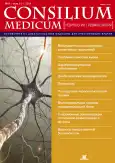Боль в спине и дегенеративные изменения позвоночника: новые данные и современные возможности для рациональной терапии
- Авторы: Сергеев А.В1
-
Учреждения:
- ГБОУ ВПО Первый МГМУ им. И.М.Сеченова Минздрава России
- Выпуск: Том 16, № 9 (2014)
- Страницы: 64-69
- Раздел: Статьи
- URL: https://journals.rcsi.science/2075-1753/article/view/94172
- ID: 94172
Цитировать
Полный текст
Аннотация
Ключевые слова
Полный текст
Открыть статью на сайте журналаСписок литературы
- Airaksinen O, Brox J.I, Cedraschi C et al. Chapter 4. European guidelines for the management of chronic nonspecific low backpain. Eur Spine J 2006; 15 (Suppl. 2): S192-300.
- Government Accountability Office. Medicare Part B imaging services: rapid spending growth and shift to physician offices indicate need for CMA to consider additional management practices. Washington, DC: Government Accountability Office, 2008.
- Van Tulder M.W, Assendelft W.J, Koes B.W, Bouter L.M. Spinal radiographic findings and nonspecific low back pain. A systematic review of observational studies. Spine 1997; 22 (4): 427-34.
- Lawrence R.C, Felson D.T, Helmick C.G et al. Estimates of the prevalence of arthritis and other rheumatic conditions in the United States. Part II. Arthritis Rheum 2008; 58 (1): 26-35.
- Battie M.C, Videman T, Parent E. Lumbar disc degeneration: epidemiology and genetic influences. Spine 2004; 29 (23): 2679-90.
- Подчуфарова Е.В., Яхно Н.Н. Боль в спине. М.: ГЭОТАР-Медиа, 2010.
- Varlotta G.P, Lefkowitz T.R, Schweitzer M et al. The lumbar facet joint: a review of current knowledge: part 1: anatomy, biomechanics, and grading. Skeletal Radiol 2011; 40 (1): 13-23.
- Videman T, Battie M.C, Gill K et al. Magnetic resonance imaging findings and their relationships in the thoracic and lumbar spine. Insights into the etiopathogenesis of spinal degeneration. Spine 1995; 20 (8): 928-35.
- Suri P, Miyakoshi A, Hunter D.J et al. Does lumbar spinal degeneration begin with the anterior structures? A study of the observed epidemiology in a community - based population. BMC Musculoskelet Disord 2011; 12: 202.
- Goode A, Marshall S.W, Renner J.B et al. Lumbar spine radiographic features and demographic, clinical and concomitant knee, hip and hand OA: The Johnston County Osteoarthritis Project [in press]. Arthritis Care Res 2012.
- Goode A.P, Carey T.S, Jordan J.M. Low back pain and lumbar spine osteoarthritis: how are they related? Curr Rheumatol Rep 2013; 15 (2): 305.
- Balagué F, Mannion A.F, Pellisé F, Cedraschi C. Non - specific low back pain. Lancet 2012; 379 (9814): 482-91.
- Heneweer H, Vanhees L, Picavet H.S. Physical activity and low backpain: a U-shaped relation? Pain 2009; 143: 21-5.
- Kalichman L, Hunter D.J. The genetics of intervertebral disc degeneration. Familial predisposition and heritability estimation. Jint Bone Spine 2008; 75: 383-7.
- Karppinen J, Solovieva S, Luoma K et al. Modic changes and interleukin 1 gene locus polymorphisms in occupational cohort of middle - aged men. Eur Spine J 2009; 18: 1963-70.
- Burton A.K, Balague F, Cardon G et al. Chapter 2. European guidelines for prevention in low back pain: November 2004. Eur Spine J 2006; 15 (Suppl. 2): S136-68.
- Roelofs P.D, Deyo R.A, Koes B.W et al. Non - steroidal anti - inflammatory drugs for low back pain. Cochrane Database Syst Rev 2008. CD000396.
- Reginster J.Y, Deroisy R, Rovati L.C et al. Long - term effects of glucosamine sulphate on osteoarthritis progression: a randomised, placebo - controlled clinical trial. Lancet 2001; 357: 251-6.
- Towheed T.E, Maxwell L, Anastassiades T.P et al. Glucosamine therapy for treating osteoarthritis. Cochrane Database Syst Rev 2005. CD002946.
- Sodha R, Sivanadarajah N, Alam M. The use of glucosamine for chronic low back pain: a systematic review of randomised control trials. BMJ 2013; 3 (6): e001167.
- Van Blitterswijk W, Van de Nes J, Wuisman P. Glucosamine and chondroitin sulphate supplementation to treat symptomatic disc degeneration: biochemical rationale and case report. BMC. Complement Altern Med 2003; 3: 2.
- Beebe F.A, Barkin R.L, Barkin S. A clinical and pharmacologic review of skeletal muscle relaxants for musculoskeletal conditions. Am J Ther 2005; 12: 151.
- Walker B.F, French S.D, Grant W, Green S. Combined chiropractic interventions for low - back pain. Cochrane Database Syst Rev 2010. CD005427.
Дополнительные файлы






